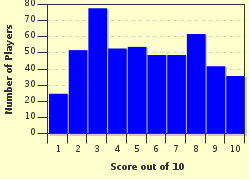Quiz Answer Key and Fun Facts
1. How many armies did Germany have on the Western Front in August 1914?
2. What Belgian fortress city was the German First Army's first target?
3. What were the names of the respective German and French plans of attack?
4. What happened to the Russian 2nd Army commander after Tannenberg?
5. Name the commanders in chief of the German, French and British armies (respectively) fighting in Belgium and France in August 1914.
6. What country was conquered in August 1914?
7. The French based their offensive tactics on "elan," or fighting spirit. What effectively destroyed French elan during the Battle of the Frontiers?
8. To crack Belgian forts, what weapon did the Germany army employ to deadly effect?
9. What formidable fighting team emerged from the battle of Tannenberg?
10. What was the name given to the disjointed series of battles that stopped the German march on Paris?
Source: Author
BigMoStl
This quiz was reviewed by FunTrivia editor
bloomsby before going online.
Any errors found in FunTrivia content are routinely corrected through our feedback system.

